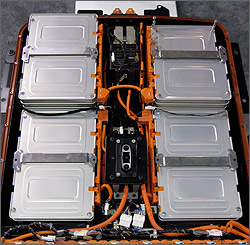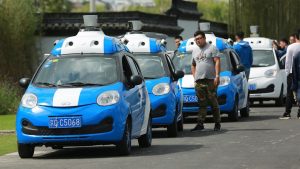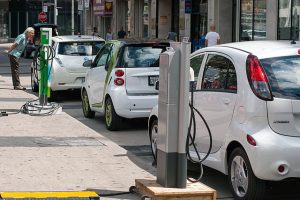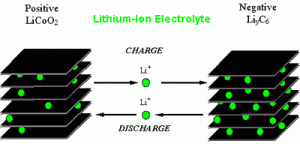Almost everyone has heard of Elon Musk. Virtually no one knows who Akira Yoshino is. Which is analogous to fiction – vs. fact – about electric cars.
Yoshino is the guy who pretty much invented the lithium-ion battery back in 1985, so he knows a thing or two about the technical and economic problems which must be overcome in order for electric cars – which are powered by really big lithium-ion battery packs – to be viable as mass-market, affordable, everyday-driver cars.
Especially automated electric cars – the ones which will supposedly be used to game-change the car business by rendering obsolete the concept of individual ownership, to be replaced by transportation on demand. To be provided by fleets of automated electric cars.
For them, the technical and economic problems are even more serious than for the individually owned electric car – because they will be expected to operate almost continuously, without major downtime for recharging. Consider the implications of this.
Yoshino has. The industry ought to.
“A car shared by 10 people means it will be running 10 times more,” he explains.
“Durability will become very important.”
Indeed.
And durability is a problem when a battery pack is in near constant use, subjected to repeated daily discharge/recharge cycling – which would be necessary for the transportation as a service idea to work. Well, for it to work without doubling (or tripling) down on the number of cars that would comprise the automated/transportation-as-a-service fleet – most of them offline at any given moment due to battery wilt.
Yoshino, who developed rechargeable lithium-ion batteries for applications such as portable cameras, laptops and the like says that “… cars are a completely new application, and we’ll have to wait until we find out what kind of batteries will really be needed. The future of batteries depends on what will happen to the future of the automobile society.”
He means that what works well in a small electronic device works differently in a large mechanical device.
A laptop’s power requirements are comparatively minimal – a fraction of the power requirements of even a cordless drill (which also uses the same battery technology). And an electric car uses many orders of magnitude more power than an electric drill. Think about the leverage need to get a 3,000 pound car moving from rest. If you have tried to push a car with a dead battery – electric or not – you’ll know exactly what’s involved.
Also: The more power used, the faster it gets used. 
And to get power back into the battery takes time – perhaps the electric car’s biggest functional problem given that most people want to get back on the road in a few minutes or less. To address that problem, manufacturers of electric cars and manufacturers of batteries have been working to develop faster charging rigs, which pump twice the voltage of the common household outlet into the battery. This knocks down the charge time from hours to a bit less than an hour. Still, too long.
And it taxes the battery, per Yoshino san.
Fast charging works on a battery in much the same way that rapid pressurization/depressurization cycling works on the fuselage of an airplane: It fatigues the metal faster. Which shortens its useful life.
Just so, the battery’s durability – its useful service life – is affected by how fast (and how often) it is subjected to recharging cycles. This is why you slow-charge new/out-of-the-box batteries. And it’s why electric car battery packs also do better when slow-charged. 
This is chemistry and can’t be gotten around – assuming the battery technology in use.
Which means there is a big problem insofar as automated electric cars for transportation-as-service. It won’t work if they aren’t durable – think about the life of a New York City taxicab – and they can’t be durable if they are in regular use (like a New York taxi cab).
Almost no one in the car press wants to talk about this – and Yoshino is getting crapped on for breaking ranks and saying such truthful if nettlesome things publicly. It upsets the applecart of the automated electric car future that’s being pushed on us even more aggressively than acceptance of gender fluidity.
Elon, of course, tells us that these problems will be solved shortly. But these assurances may be of a piece with predictions that “peak oil” is just around the corner . . . and that we will be sending tourists to Mars within five years.
Elon, after all, is a carny barker – not an engineer.
Yoshino san, on the other hand, is an engineer – and thus, worries about nettlesome facts, while questioning extravagant promise-making.
. . .
Got a question about cars – or anything else? Click on the “ask Eric” link and send ’em in!
If you like what you’ve found here, please consider supporting EPautos.
We depend on you to keep the wheels turning!
Our donate button is here.
If you prefer not to use PayPal, our mailing address is:
EPautos
721 Hummingbird Lane SE
Copper Hill, VA 24079
PS: EPautos magnets – they’re back! are free to those who send in $20 or more to support the site. Also, the eBook – free! – is available. Click here. Just enter you email in the box on the top of the main page and we’ll email you a copy instantly!












Bloomberg: Electric Car Drivers Are Too Smart to Own Electric Cars
https://www.bloomberg.com/news/articles/2018-01-03/why-most-electric-cars-are-leased-not-ow
Wish I could afford an EV, this evening after the subzero mornings when I was changing oil in the “Fit” ( trans needs service next) but the little sucker is a heck of a lot easier to service than the other 3 Hondas in the fleet(Element, Accord, Civic-wife will not have anything else) but, I have noticed the Hondas are not fuel economy champs and I think it has to do with the manufacturers ass backward attempt to get good mileage, if they had bigger engines they would probably get better gas mileage, these steep grades and shitty roads take a toll on mileage found that out the Hardway with the Dakota the little V6 engine gets about the same mileage as the optional V8 in the sub 5 thousand pound pickup.I don’t even know why Dodge even bothered to put an engine like this in pickup ,it has a real POS 4 speed transmission and doesn’t even have an electric fan( the AC and more importantly Heater work very well)You may wonder how a little truck like that could weigh so much , it was because of regulations, to improve crash worthiness they added about 2-300 more lbs of metal on the front end, plus an overall poor design it bites.I have said many times if I had the choice between 10 extra HP or 300# weight reduction , I would take the weight reduction.It takes fuel to move mass, the Powertech V6( with good care has gone about 109K so far from what I hear it could grenade at any time ) if it blows I might repower or just part out.Funny thing is it seems a GM LS is one of the easiest engines to put in these vehicles.One of the things that queers the engine swaps is the engine management computer, well you know what might just have hung a GM computer on the OL’ Dodge somewhere and I would probably just acquire the GM V6, compact, powerful and lightweight( It seems to be a major chore to stick a Pentastar in one of those Dakotas. Guess I could find a powertech V8( its bit of a chore too.) Think I’ll just get another vehicle, so much for my rodding aspirations, the problem is despite the crappy brakes( ever see something with one return spring on the rear drums?) I like the size and height of the Dakota and though I really could get by without 4WD , the 4wd has spoiled me
A 90s CK with a warmed over vortec would be about my speed, the problem is , the frames are basically rotted out on the native trucks( heck with it , think I will go to Costa Rica)
You’re so right, Kevin. I’ve always known the same thing- under-powered engines have to work at full capacity all of the time, so they get horrible mileage. A bigger engine in the same vehicle that would barely be working half the time, would get better mileage. Gearing makes all the difference too. Small engine=they have to gear the car low….so the injun’s operating in the top range even more.
My 8K lb. Excursion with the V-10 gets better mileage than any other gas-engined truck I’ve ever had- even if they weighed half as much. Weight isn’t even very impostant. And if my Exc. wasn’t geared low, it would get amazing mileage.
My old Lincoln Town Car used to get 23MPG- a comfy full-size car with a V-8. Meanwhile, half the people I know with little 4-banger shoeboxes more than a few years old are barely getting 23MPG.
EVs are no answer though…in extreme cold, I’d bet they’d have a range of about 40 miles…..
Automated electric cars are, at a basic level, products that are not made for technological reasons (a better, faster, longer lasting, or lower maintenance solution) or economic reasons (cheaper to buy, cheaper to use, cheaper to maintain, impose fewer costs on society), but products made for political reasons.
Those political reasons are about propitiating the Safety Uber Alles and the Climate Change Gods.
The problem is, automated electric cars don’t necessarily solve the problems with today’s cars, and bring problems of their own that today’s cars don’t have, such as software glitches that cause accidents and the need to dispose of highly toxic and flammable batteries.
But the real political agenda is not to prevent injuries and protect the environment, but to get people out of their cars; the better for Uncle to control them. After all, people don’t drive themselves to the gas chambers and gulags, now do they?
They know this [automate car-share] can not work.
They will implement it anyway.
This is how they effectively outlaw private personal autonomous transportation. Replace the current infrastructure which does work, with one that doesn’t work. Then act all surprised when the new scheme doesn’t work, and there is nothing left of the old infrastructure to go back to.
This is why hucksters like Musk[rat] are glorified, while the truth-tellers are ignored, vilified and belittled, and shoved into the corner. “They” don’t want anyone to know that they already know that this system can not work, because then they would not be able to implement it….and, after all, it is so much easier to outlaw private ICE cars covertly, rather than overtly- ‘specially when they want us to think that they have our best interests at heart.
Green is the new Red. The new regime’s plan is to convert everything over to renewable energy by 2050 in the Soviet State of NJ and other “blue” states. Although this is the stated plan, the real plan is to destroy the remnants of (small and big business not on board with the plan), western civil society and culture, and continue to import a new culture and with the wealth extracted from productive elements move onward and forward toward the new day of communism.
Most actors don’t see the big picture at all. If they do they don’t think it will work or do any good but that doesn’t matter to them if they are getting paid good money to implement it. It’s a script that a bunch of actors are following.
To this end, private lands will be taken in the name of frogs, dragonflies, birds et cetera. It will be a new age of “environmental reparations” with increasing lawsuit predations upon businesses. Unlimited ponzi scheme bond moneys fronted by goldman sachs and their ilk will buy your land at “fair market value”. The land on which the all rights have disappeared will then be patrolled by nazi/communist stormtroopers for the “public”.
“Urban renewal” will continue to be the gaping black hole for the goodies extracted from the productive elements of society, by hook or by crook, as this act insinuates the political means by which all this is to be accomplished.
Environmentalists have been some of the most dishonest people in their misguided attempts to “save the planet”. Our earth is much more resilient than they would have you believe. Environmentalists see humans as a “pestilence”. They would like to see the human population reduced (by any means necessary) by around 90%. The survivors would be walled-off in soviet-style high-rise apartments, riding bicycles, taking trains and buses while the wilderness areas would be available only to these “anointed” environmentalists.
I, for one, have no use for these limp-wristed, birkenstock-wearing, prius-driving, tofu-eating poor excuses for human beings. I would suggest that environmentalists take their own advice and eliminate themselves first.
Environmentalists are like watermelons–green on the outside and red (communist) on the inside. It’s always been about control.
I CHEER when I hear a of a “greenpeace” ship getting blown out of the water. . .
Rarely commented on as well – the massive electrical generating capacity required to produce all the energy formerly supplied by gasoline. China has proclaimed an electric car future, but in Beijing right now coal-plants are being reactivated to produce heat for homes.
So GM has been making CNG light trucks for a decade or more. Where is the downside? They aren’t as powerful as gasoline or diesel but how many people use full throttle more than briefly in a light truck? Ok, some do work light trucks hard so gasoline and mainly diesel are good for those jobs. And I can tell you, we have a glut of natgas in Tx. alone.
Of course we can’t even mention diesel cars now for no “good” reason. This is the stuff promulgated by no-nothing fools. That same mindset that supplies livestock to “upset” college students to calm their poor little nerves. It’s common now to see Alpaca’s and Llama’s guarding sheep. They do so because they have some formidable teeth and hooves to kill coyotes and such. I keep waiting to hear little Suzie got her fingers bit off…..which no one will ever admit. If we’d had special rooms to make us feel secure and calm our nerves when I was in college probably the only time the door would open for several days would have been to accept deliveries of beer, pot, condoms, ‘ludes, KY and burgers. How nice that would have been when nobody could bother you. Our main worry with cars was money for gas.
EV’s are a poor replacement for IC motored transportation.
However, the question I’ve yet to get a decent answer to is, why not have a universal battery pack that can be changed in a matter of seconds or minutes?
My DeWalt impact came with two bat’trees. When one dies out I swap it in seconds for the charged one and put the dead one on a charger. Why not have stations where cars come in, drive over a changing device that removes the dying battery, puts it on a charging carousel and puts a charged unit in its place?
EV’s cannot efficiently replace IC at this time. It may never happen. But, if this concept of standardized battery replacement could be implemented it would certainly make the alternative of an EV more doable…so long as they pay their own freight and don’t expect the rest of us to subsidize their virtue signalling.
Hi Mark,
Imagine what would be required in terms of infrastructure for this to work: It would be necessary to build a vast network of automated facilities comparable to the number of gas stations which currently exist, where robots could remove/replace battery packs. This would entail billions, probably, to build. Who will pay?
These automated facilities would have to be capable of changing out a battery pack in a few minutes (comparable to the time it takes to gas up a car) or cars would stack up and there would be huge lines – and huge delays. Imagine lines of EVs hundred of yards long, waiting for their turn.
A way would also have to be found to deal with the problem of people returning damaged batteries and trying to replace them with undamaged ones. It would probably mean replacing the anonymity of buying gas – which you can still do with cash – with having to sign up for a debit account that ties you/your EV to payment system of some kind. More Big Brotherism.
It’s a huge clusterfuck.
And, again, I ask the question: WHY?
Why is there this shove in the back toward expensive, problem-plagued EVs when IC cars work so brilliantly?
Everyone keeps trying to come up with ways to make EVs “work” – but the fact remains that IC cars work better. It is very odd, this inversion. This pushing for a replacement that is inferior.
Yes, yes. EVs are silent and quick and you can charge at home and some people think they are sexy.
But are they more practical? More economical? More durable?
No!
I can’t think of another example of something that is all of those things being forced off the market in favor of something that is none of those things.
To make the battery pack easy to remove let alone automated would have significant weight and cost penalties. Then there is getting stuck with a multi-thousand dollar turd when people learn to game the system to get rid of packs that are at eol or simply damaged.
Mark, 18V dewalt batteries are quite heavy to handle for small wrists and small arms. 20V and 24V are even worse. Your tool batteries are quite easy to handle in comparison to car batteries. Note how heavy a IC car battery is even for a smart car. Battery technology is not the same as computer technology as it is dependent on chemical reactions taking place to deliver power.
Batteries to move substantial masses are going to be quite heavy.
Also note how a Thiokol engineer recommended not launching the Challenger shuttle. He was overruled by management, and never able to obtain work after that as an engineer. I can tell you from working in the quality control field that honesty in the last few years is not tolerated. Only the company mantra of money money money is all that matters. This bloke will be relegated to an isolated corner of his office if he still has a job after this expose.
There was an Israeli company called “A Better Place” which was founded on this premise.
It flamed out spectacularly.
https://amp.fastcompany.com/3028159/a-broken-place-better-place
Teslas are actually designed to do just that. The battery pack is on the bottom of the car and there is a mechanism to swap out batteries in a few minutes.
It turns out that none of the Tesla owners are interested in this method of charging. Tesla tried it with an experimental station in California somewhere everyone just used the superchargers instead.
As a practical matter, I never spend time charging my Tesla because I just plug it in each night when I am finished driving for the day. It is always topped up and pre-warmed up in the morning because it uses house power to preheat instead of the battery.
As I mentioned in another thread here, I spend about 4 seconds plugging in and 4 seconds unplugging each day * 7 days = 56 seconds / week of my time dealing with fueling the car. When I owned a gasoline car, I spent at least 5 minutes a week to fill the tank.
So ironically, I spend less time fueling my Tesla than my gas car.
I haven’t taken any long trips (long meaning beyond the 315 mile range of the battery), so it is to be determined if the time spent between superchargers is long enough that I would have stopped for the half hour it takes to charge anyway to stretch out and get something to eat, etc.
your Tesla’s battery weighs as much as a Volkswagen, and has a tiny pin plug which has to be precisely lined up. It takes a crew of several technicians, TWO huge dollies, and about a half a day to swap. If you don’t believe me, go to your local tesla dealer, and tell them you want your battery swapped-out
They dont want electric cars for their green-ness, but because they are cars that can more easily be controlled…. and Mr Musk is the chosen one to implement that future. Its amazing how on one end nothing he says is challenged by the media. That electric truck thing – really? I mean the model S carries a battery pack weighing approx 550 KG, to be able to take only 400 KG (thats the max weight it can carry, about as much as a mini), for 300 miles (at best). Now they are saying, with essentially the same battery technology they will carry about 35,000 KG for 500 miles!! How does that ever add up….
On the other hand, apparently the new model 3 has an inside camera to keep an eye on who is IN the car!!
That something is the hydrogen fuel cell.
Cars can be refunded by hydrogen stations.
The technology exists.
Look up Ballard Power.
Still involves internal combustion, so nope. Remember IC is baddddddd! Even if it is clean, which most new gas powered cars now are.
Fuel cells are not Internal Combustion, they convert H2 to H2O and produce electricity. There is nothing but water vapor produced in this reaction. I used to own shares of Ballard and Plug Power almost 20 years ago – the two have long since merged. The technology is always on the horizon to being adopted since the 1890’s. It appeared closed in the early 2000’s but only has been used in specialty applications. Ballard was producing electric drives for busses in the 1990’s. A fuel cell can use natural gas or hydrogen as the energy source. Plug Power was manufacturing fuel cells for building electrical needs with eyes on home power generation in units the size of conventional home furnaces.
A hydrogen economy is dependent on cheap electricity to split water in hydrogen and oxygen. Hydrogen has drawbacks noticeably the Hindenberg. It is flammable and has to be stored in pressurized containers. There was supposed to be an inventor that had produced a solid form of hydrogen storage but I have not heard anything of that in a long time.
The idea was for cheap solar electricity to power the manufacturing of hydrogen – Solar panels are increasing in efficiency but quite slowly. Then there is the matter of how much efficiency is lost in the system to each phase of power transfer. Energy is required to manufacture the hydrogen, more energy to store it and energy is lost in the conversion from storage to use.
Hydrogen is far more promising than lithium electrical storage. The fact remains the choke points are still the electricity needed.
Chrysler actually developed a fuel cell that “cracked” gasoline into its components with a minimal amount of pollution. Such a system would work as the gasoline infrastructure is already in place…I wonder why it was abandoned…
I thought the problem with hydrogen was storing it. Its small size lets it escape containment.
Frankly if they want a pure electric car, they are barking up the wrong tree with batteries. They have to come up with something else.
In some ways, hybrids are the “solution”, but they hate IC so………….. Of course if the market was the ruler, they probably wouldn’t be bothering with electric at all…….. Its a problem only the government and greenies think is a problem. IC cars are in many ways better then ever.
Batteries are too big, too expensive, don’t have enough range, take too long to recharge, don’t last long enough, aren’t that “green” to begin with. Then you have to fight against basic chemistry. You can’t outlaw by edict, basic science no matter how much you want to.
Solving even one the problems with batteries is a giant task. I don’t see them doing it since they all go about it the same way.
If anyone actually comes up with something practical to power an electric car, it won’t be a giant company, a university or government lab. It will be some guy in a garage or basement. So it likely won’t see the light of day………..
Well there is nuclear. I remember my junior high school science textbook stating that a single pellet of enriched Uranium could power a car 500x around the earth.
What was the size of the pellet? 5 micrograms, 1 gram, 1000000 grams? A pellet can be any size, whatever size you want.
Very very small amounts of uranium yield very very high amounts of heat.
http://www.explainxkcd.com/wiki/index.php?title=1162:_Log_Scale
But that 500X around the Earth figure assumes all the available fissionable material is converted to heat. In the current US nuclear fleet only about 5% of the material is used because it is cheaper to mine new uranium than recycle old fuel and also thanks to the failure of regulators to implement an effective recycling plan.
One of the reasons I became a libertarian is because of the horrible mismanagement of the power industry, and nuclear energy specifically. Here’s Ayn Rand’s engine to run the universe in real life, and Uncle can only use it for destruction, and do everything short of executing plant operators to prevent expansion.
Meanwhile in Canada, they’ve shut down all the coal plants and France continues to have the lowest CO2 output of any industrialized nation. Oh, and France has an effective efficient electric vehicle network in place. It’s called the TGV and it runs on nuclear power. If the TGVs had to carry their power source with them there’s no way the rail network would be possible.
We just need to install Mister Fusion in the DeLorean and we’ll be good to go ?
I wanna ride with Jim Ignatowsky* instead of that Professor guy!
[*=Jim Ignatowsky a.k.a. Reverend Jim was a burnt-out ex-hippie character played by Christopher Lloyd on the sitcom “Taxi”]
https://www.youtube.com/watch?v=AI_Qijvs8OQ